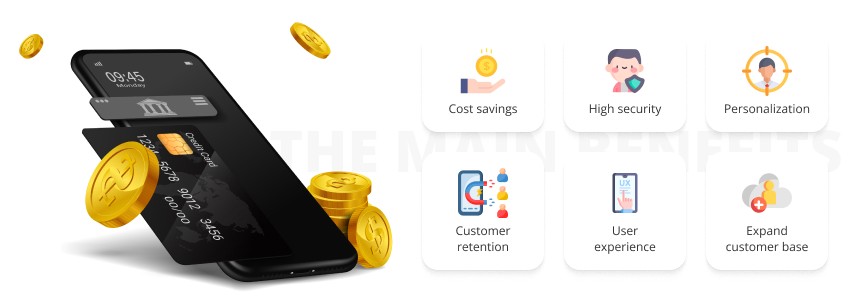Let’s work together to build something amazing. Share your project details and our team will reply to figure out the next steps to your success.

In this article, we will describe how to create a mobile banking app that attracts users and provides essential functionality. We will also take a look at the current technologies for mobile banking app development and go over the basic steps of the development process.
Contents:

The Main Benefits of Creating Mobile Banking Apps
Why should an innovative bank consider creating a mobile banking application? Let’s weigh the main benefits of developing an app and how it will lower costs, increase customer retention, create an efficient user experience, and expand banking revenue streams based on the app’s ability to target users with personalized financial products
Cost savings
First, mobile apps provide automation and process optimization. Your customers will spend less time calling the bank customer support system or visiting a branch office, as they can find most answers to key questions at their fingertips in the app. Furthermore, AI-driven chatbots can be implemented within or alongside the app to offer solutions to most requests and mitigate a substantial amount of the burden from the customer support team. As a result, you can strategically reduce front and back office staff, digitize paperwork, and eliminate redundant branches, which will positively impact your expenses while enhancing customer satisfaction
Customer retention
Apps are interactive, and engaging to stimulate user focus and rentention. They engage with users by sending notifications, reminding users of their balance, and offering special discounts or deals. Banks drive customer retention when they offer digital banking services. Mobile applications provide convenience and accessibility, allowing customers to view targeted offers, order another card, make transfers and all other key banking transactions in the app.
User experience
anking apps that have an excellent user experience gain a competitive edge. There are numerous features that enhance the app’sUX and make a best in class app stand out such as: 24/7 chatbots, expense analytics tools, and a dynamic personal finance management system. Enabling these outstanding in-app features for your users makes your banking services versatile, useful, and attractive.
High security
Before the advent of mobile apps, bank customers interacted with banking services using online accounts that were the first step in digitizing and simplifying access to banks. However, browsers are far less secure and expose user data to greater vulnerabilities compared to secure mobile applications. Using advanced mobile app development technologies, businesses can create mobile banking applications with a high level of security. Protecting user data, especially in the fintech industry, is crucial as exposure thereof can lead to significant financial and reputational losses.
Personalization
Personalization is one of the biggest trends in app development, and banking and finance app development is not an exception. Using innovative technologies like AI and Machine Learning, a bank can collect customer data, analyze behavior and make personalized suggestions to further increase satisfaction flowing from the user experience. Metrics based on user behavior provide key insights and access to vital information about how customers interact with the app can be leveraged to make the overall experience better for users while simultaneously targeting services / financial products based on the insights gained
Expand customer base
Finally, banks that provide modern mobile applications broaden the spectrum of possible clients and allow banks to create a global customer base. Banks that offer a full digital suite of services can transition their advertising focus to the internet and mobile application ecosystems. Reaching a young and sophisticated audience with targeted advertising campaigns that are more effective at a lower cost then legacy media devices (TV etc.).
Wondering where to start?
Let us find a solution that meets your real business needs

Key Technologies That can be used to Create a Banking Application
We will explore three main approaches to building a mobile banking app solution: a native app, a cross-platform tool, and a hybrid application. There are pros and cons to each method and different technology stacks that can be chosen based on business objectives.
Native code
Native mobile app development refers to creating a strictly iOS or Android application. Native apps run faster and perform better than any other solution. We will discuss the benefits and drawbacks of native code.
Pros of native app development:
Native solutions provide better performance, which drives user experience and retention. Accordingly,native apps give coders access to native device features such as the camera, GPS, and Bluetooth and to build more advanced solutions.
Cons of native app development:
Native app development may require larger investment and offer a longer time to launch on an application marketplace. A key decision that must be weighed by the product owner is whether hiring multiple teams fits within the budget and business objectives of the bank. It may be advantageous to engage two teams to build separate applications for iOS and Android. Hiring two teams will cost significantly more than building a cross-platform app with one team.
However, key business decisions can drive the focus on one platform before the other. For example a business that determines that it wants to solely target iOS users based on higher spend rates may decide not to run two teams and stagger / stage development. At Aleph One we help businesses make this type of decision versus the conventional wisdom of requiring development by two teams.
Technologies:
iOS: Objective-C vs. Swift
Objective-C is an old and stable technology that has been in use for decades. It comes with a considerable amount of supporting tools and a vast community. Objective-C is considered an aging technology that will be obsolete in the near term.
Swift is a relatively new language that has been officially endorsed by Apple. The community is rapidly growing, and the toolkit is expanding, making it a great iOS development language. Swift is known for allowing much faster coding, which shortens the application’s time to market.
Android: Java vs. Kotlin
Java has been around for two and a half decades and has acquired a large community of dedicated coders. It is easy-to-use and offers safety and reliability due to several Google and Apache supported libraries.
Kotlin is a newer language that is easy to adopt due to its interoperability with Java. Kotlin is faster, simpler, and allows building high-performance applications. Finally, this technology enables the creation of server-side, client web, and Android mobile applications.
Cross-platform code
Cross-platform app development refers to writing a single piece of code that runs across platforms. Essentially, developers can develop one application that will run on both iOS and Android saving valuable resources. However, there are downsides to cross platform development.
Pros of cross-platform app development:
The benefits of platform-independent app development are primarily cost and time savings. Instead of employing two teams, you will create a mobile banking app with just one. Besides monetary benefits, the application will launch on an expedited time frame. Allowing the banking app solution to enter the market faster than your competition and reach users before the rest of the market in order to facilitate rapid penetration.
Cons of cross-platform app development:
At the same time, cross-platform development is known to deliver apps with a less polished user experience. Some features that depend on native device features are impossible to build with a cross-platform application. This limitation deteriorates the experience and makes the app less impressive and slower compared to native solutions.
Cross-platform Code Technologies
React Native vs. Flutter
Flutter is cross-platform development technology that allows businesses to expedite the creation of impressive apps. Flutter has comprehensive and detailed documentation and support from a fast-growing developer community.
React Native is a well-established Facebook-created application framework that is used to create native-like apps. React comes with a variety of learning materials and tutorials, which noticeably shortens the developer learning curve. Finally, React is known for allowing the reuse of up to ninety percent (90%) of code for both web and desktop app development.
Hybrid code
Hybrid app development refers to using plugins like Ionic’s Capacitor to embed the code written with HTML, CSS, and JS into a native app. Hybrid apps suffer from the same type of issues that are a challenge for cross-platform apps.
Pros of hybrid app development
Hybrid app development significantly shortens the development time by deploying an application to both operating systems. Hybrid method provides code reusability and serves as an affordable alternative to native apps.
Cons of hybrid app development
Hybrid apps can exhibit poor user experience and limited features. Hybrid applications usually have performance issues and are slower to load a page. Even though this type of development can achieve a near-native feel, hybrid apps will not provide the same sophisticated visual experience.
Hybrid Code Technology
Ionic
Ionic is the best tool for hybrid app development, as it is easy to learn and provides a rich collection of features. Allowing developers to write fewer code lines and use Ionic debugging tools, the framework helps to create mobile apps on a shorter timetable.

Increased Customer Satisfaction Through Enhanced Functionality
Developing a mobile banking application is a lengthy and expensive process, it is essential to create a good product that will attract the target customer base. There are a few tips that could help a bank deliver the essential parts of a modern banking solution.
Ensure intuitive transactional experiences
The most crucial function of a successful banking app is the transactional experience. The experience must be intuitive and straightforward for each customer. Make sure users can perform simple tasks in one or two clicks, and the app will be a success.
Build in the customer support
Over time users will need customer support. Ideally, the app should offer a 24/7 support button that is in an easy to see location. If customers need to browse through FAQ pages to find an answer to a simple question, they will soon abandon the application and look for a more user-friendly product from a competitor.
Make user navigation simple
A critical aspect of a successful banking application is intuitive navigation. Users should not be forced to learn the intricacies of app navigation. Consider offering an extra layer of navigational simplicity by implementing a virtual assistant system to walk users through the app’s features / navigation.
Offer personalized features
As discussed above, personalization is the core of a dynamic user experience. Collect and analyze customer data to generate user behavior metrics to offer personalized suggestions and targeted financial products / services. Enable notifications and alerts to nudge users to consider special offers and deals. Alerts can be used to notify users about key offers / events that apply to all users equally. For instance, user notification when bank balances fall below a certain number threshold, when a credit payment is due, and offer other customizable triggers that can be automatic or user generated.
Include financial management
Developing a mobile banking app that goes beyond simple transactions must include bundled services that attract and retain users. A financial management feature is a useful addition to an all-in-one app for private individuals and small business owners. Adding a simple financial analyzer with visuals that display income and spending could benefit a bank’s client base and will form the foundation for increasingly complex systems if the bank determines customer demand.

6 Basic Steps of Creating Mobile Banking Application
In this section, we will focus on how to build a mobile banking app. There are several basic steps that every business owner needs to take if they want to succeed in custom mobile banking app development.
#1 Conduct market research and create a plan
Before any mobile banking application development project begins, gather relevant data to define the scope and requirements. It’s important to conduct thorough market research and collect information about competitors to avoid common mistakes and create a product that will stand out. In addition to studying the market, it’s necessary to learn about the target audience, their needs and pain points.
By the end of this phase, a business / project plan that includes a comprehensive scenario of how the project will unfold, including the duration, financial constraints and goals, technical requirements, and monetization strategies. Aleph One specializes in walking a business owner through the creation of a comprehensive technical project plan to meet any business needs.
#2 UI/UX Design
How to start a banking app that will attract an audience and convert it into a user base in a competitive market? The answer lies in progressive and sophisticated UI/UX design. This phase ends with the creation of several wireframes with UIs for each app page that shows how the user will be able to interact with the application. When planning a large project with a complex product, consider building a mobile banking app prototype to test the feasibility of the idea.
#3 Development
The next stage is the development phase when the actual coding takes place. This phase will require two teams of engineers, one for the frontend of the app and one for the server-side. The frontend refers to the user interface and how users will interact with the application. In other words, frontend is what users will see when they download and use the app. Backend is the backstage of the solution and deals with servers and databases. Make sure to hire experienced developers for this part, or consider outsourcing the project to a software development company.
#4 Testing
There are many types of testing that will need to be accomplished before an application can be officially launched. To make sure the product is release-ready, have a QA team run different tests to validate the performance, speed, reliability, and any other mission critical aspect of the app. Testing is an extensive and challenging process that requires precision and expertise. Neglecting this phase will result in a poor user experience that will kill the applications’ reputation on the market and drive away users while hindering user conversion / retention.
#5 Marketing & Deployment
At this stage, launching the marketing and monetization plans that have been prepared in the first phase. Regardless of how great the product is, no one will ever know about it unless time and money is spent on smart marketing activities to drive market exposure. It is essential to acquire marketing and sales tools to compile and visually aggregate key metrics and to facilitate data-driven business decisions.
#6 Maintenance & Support
The project will not end with the launch as post-release maintenance and support are critically important. Make sure to continuously collect feedback to update and add features and make the application more attractive for users.
Average Cost of Development Services for Creating a Mobile Banking Application
To understand how to build a banking app on a budget, this part of our guide is essential. The cost of digital banking platform development depends on three major decisions: features, technology, and location of the tech team.
- Feature density
As some features take longer to develop and require more expertise from developers, they come with a higher price tag. It is recommended to concentrate on a few functional or essential features at first and gradually add more functions as they become necessary over time.
- Technology
As detailed above, creating a native application requires more funds than building a cross-platform or hybrid solution. The choice of technology will be a critical factor that helps determine the overall cost of development for the mobile banking app project.
- Location of Developers
Location is also a decisive factor in determining development costs, as hourly rates of engineers from the US or Western Europe are on average higher than from Eastern Europe.
Here is a limited overview of the differences in the salary of iOS, Android, cross-platform developers, and designers from the US, Germany, and Ukraine.
| US | Germany | Ukraine | |
| Native developer iOS | $130-250 | $120-175 | $50-80 |
| Native developer Android | $150-170 | $120-175 | $45-75 |
| Cross-platform developer | $130-150 | $60-80 | $50-60 |
| Designer | $50-150 | $50-100 | $25-50 |
Hourly rates differ from location to location. However, they are also contingent on the agency and their level of expertise. Contact Aleph1.io to receive a free quote and consultation regarding feasibility / project budget estimation.
Final Thoughts
Hopefully, our guide provided a meaningful introduction to the world of FinTech development and how to launch a banking app. At Aleph One we have many years of experience and know-how gained through the development of complex software products for private Swiss banks. Client banks utilize our deep experience and expert team to build world-class products and applications. At Aleph One, our core specialization is fintech software development, we can augment and supplement a bank’s understanding of the best possible application development process and strategy. Our specific technical expertise in mobile banking technology trends will help build the best solution for any bank. Contact our team to receive a free consultation and learn more about fintech from our industry-leading experts.
Get the latest news and updates from Aleph One in your inbox.

